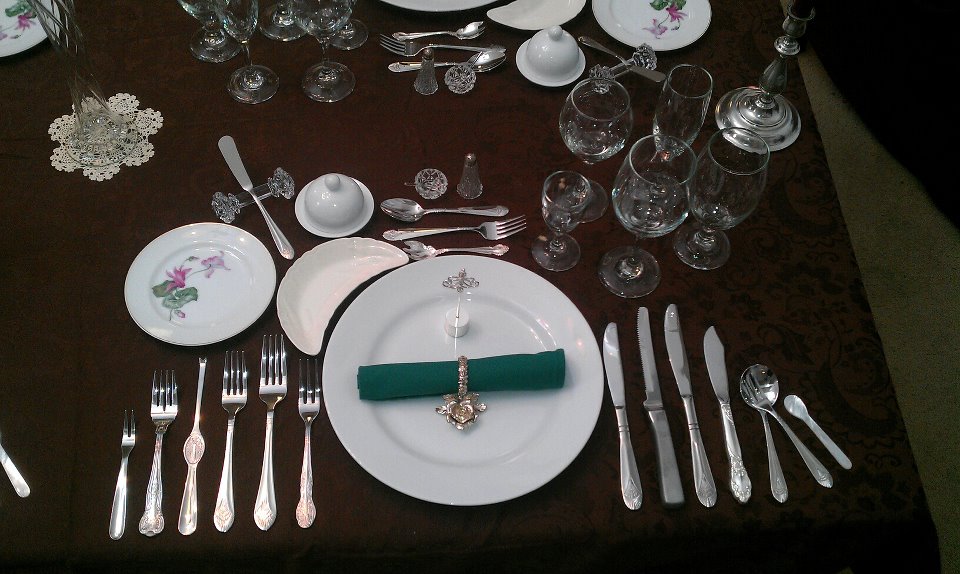Salt cellar on:
[Wikipedia]
[Google]
[Amazon]
A salt cellar (also called a salt, salt-box and a salt pig) is an article of
 Greek artifacts from the classical period in the shape of small bowls are often called saltcellars. Their function remains uncertain, though they may have been used for condiments including salt. The Romans had the ''salinum'', a receptacle typically of silver and regarded as essential in every household. The ''salinum'' had ceremonial importance as the container of the (salt) offering made during the meal, but it was also used to dispense salt to diners.
During the
Greek artifacts from the classical period in the shape of small bowls are often called saltcellars. Their function remains uncertain, though they may have been used for condiments including salt. The Romans had the ''salinum'', a receptacle typically of silver and regarded as essential in every household. The ''salinum'' had ceremonial importance as the container of the (salt) offering made during the meal, but it was also used to dispense salt to diners.
During the  Large, ornate master salts continued to be made through the
Large, ornate master salts continued to be made through the
tableware
Tableware is any dish or dishware used for setting a table, serving food, and dining. It includes cutlery, glassware, serving dishes, and other items for practical as well as decorative purposes. The quality, nature, variety and number of o ...
for holding and dispensing salt
Salt is a mineral composed primarily of sodium chloride (NaCl), a chemical compound belonging to the larger class of salts; salt in the form of a natural crystalline mineral is known as rock salt or halite. Salt is present in vast quant ...
. In British English, the term is normally used for what in North American English are called salt shaker
Salt and pepper shakers or salt and pepper pots, of which the first item is normally called a salt cellar in British English, are condiment dispensers used in Western culture that are designed to allow diners to distribute grains of edible salt ...
s. Salt cellars can be either lidded or open, and are found in a wide range of sizes, from large shared vessels to small individual dishes. Styles range from simple to ornate or whimsical, using materials including glass and ceramic, metals, ivory and wood, and plastic.
Use of salt cellars is documented as early as classical Rome
In modern historiography, ancient Rome refers to Roman civilisation from the founding of the city of Rome in the 8th century BC to the collapse of the Western Roman Empire in the 5th century AD. It encompasses the Roman Kingdom (753–509 BC ...
. They continued to be used through the first half of the 20th century; however, usage began to decline with the introduction of free-flowing salt in 1911, and at last they have been almost entirely replaced by salt shakers.
Salt cellars were an early collectible
A collectable (collectible or collector's item) is any object regarded as being of value or interest to a collector. Collectable items are not necessarily monetarily valuable or uncommon. There are numerous types of collectables and terms t ...
as pieces of silver, pewter, glass, etc. Soon after their role at the table was replaced by the shaker, salt cellars became a popular collectible in their own right.
Etymology
The word salt cellar is attested in English from the 15th century. It combines the English word ''salt'' with theAnglo-Norman Anglo-Norman may refer to:
*Anglo-Normans, the medieval ruling class in England following the Norman conquest of 1066
*Anglo-Norman language
**Anglo-Norman literature
*Anglo-Norman England, or Norman England, the period in English history from 1066 ...
word ''saler'', which already by itself meant "salt container".
Salt cellars are known, in various forms, by assorted names including open salt, salt dip, standing salt, master salt, and salt dish. A master salt is the large receptacle from which the smaller, distributed, salt dishes are filled; according to fashion or custom it was lidded, or open, or covered with a cloth. A standing salt is a master salt, so-named because it remained in place as opposed to being passed. A trencher salt is a small salt cellar located next to the trencher (i.e., place setting). Open salt and salt dip refer to salt dishes that are uncovered.
The term salt cellar is also used generally to describe any container for table salt, thus encompassing salt shakers and salt pigs.
History
 Greek artifacts from the classical period in the shape of small bowls are often called saltcellars. Their function remains uncertain, though they may have been used for condiments including salt. The Romans had the ''salinum'', a receptacle typically of silver and regarded as essential in every household. The ''salinum'' had ceremonial importance as the container of the (salt) offering made during the meal, but it was also used to dispense salt to diners.
During the
Greek artifacts from the classical period in the shape of small bowls are often called saltcellars. Their function remains uncertain, though they may have been used for condiments including salt. The Romans had the ''salinum'', a receptacle typically of silver and regarded as essential in every household. The ''salinum'' had ceremonial importance as the container of the (salt) offering made during the meal, but it was also used to dispense salt to diners.
During the Middle Ages
In the history of Europe, the Middle Ages or medieval period lasted approximately from the late 5th to the late 15th centuries, similar to the post-classical period of global history. It began with the fall of the Western Roman Empire ...
, elaborate master salt cellars evolved. Placed at the head table, this large receptacle was a sign of status and prosperity, prominently displayed. It was usually made of silver and often decorated in motifs of the sea. In addition to the master salt, smaller, simpler salt cellars were distributed for diners to share; these could take forms as simple as slices of stale bread. The social status
Social status is the level of social value a person is considered to possess. More specifically, it refers to the relative level of respect, honour, assumed competence, and deference accorded to people, groups, and organizations in a society. St ...
of guests could be measured by their positions relative to the master's large salt cellar: high-ranking guests sat ''above the salt'' while those of lesser importance sat ''below the salt''.
 Large, ornate master salts continued to be made through the
Large, ornate master salts continued to be made through the Renaissance
The Renaissance ( , ) , from , with the same meanings. is a period in European history marking the transition from the Middle Ages to modernity and covering the 15th and 16th centuries, characterized by an effort to revive and surpass ide ...
and Baroque
The Baroque (, ; ) is a style of architecture, music, dance, painting, sculpture, poetry, and other arts that flourished in Europe from the early 17th century until the 1750s. In the territories of the Spanish and Portuguese empires including ...
periods, becoming more ceremonial. In England, the ornamental master salt came to be called a standing salt, because it was not passed but remained in place. By 1588, reference is documented in England to the "trencher salt"; by the early 18th century, these had mostly supplanted large salts. Tiny salt spoon
A salt spoon is a miniature utensil used with an open salt cellar for individual service. It is a historical and nostalgic item from a time before table salt was free-flowing, as it is today. The spoon itself ranges from 2 to 3 inches (5 to ...
s appear in the 17th century, and in increasing numbers as the use of trencher salts increased.
The advent of the Industrial Revolution
The Industrial Revolution was the transition to new manufacturing processes in Great Britain, continental Europe, and the United States, that occurred during the period from around 1760 to about 1820–1840. This transition included going f ...
in the late 18th to early 19th centuries rendered both salt and salt cellars commonplace. From about 1825 pressed glass
Pressed glass (or pattern glass)
is a form of
 Silver, glass, china, pewter, stoneware, and other media used in the creation of tableware are collectible and have most likely been collected for centuries. By extension, salt cellars first became collectible as pieces of silver, glass, etc. Whether because of their commonness (and hence affordability), or the wide variety of them, or because of their slide into anachronism and quaintness, salt cellars themselves became collectible at latest by the 1930s.
Although antique salt cellars are not difficult to find and can be very affordable, modern manufacturers and artisans continue to make salt cellars. Reproductions are common, as are new designs that reflect current tastes.
Silver, glass, china, pewter, stoneware, and other media used in the creation of tableware are collectible and have most likely been collected for centuries. By extension, salt cellars first became collectible as pieces of silver, glass, etc. Whether because of their commonness (and hence affordability), or the wide variety of them, or because of their slide into anachronism and quaintness, salt cellars themselves became collectible at latest by the 1930s.
Although antique salt cellars are not difficult to find and can be very affordable, modern manufacturers and artisans continue to make salt cellars. Reproductions are common, as are new designs that reflect current tastes.
Medieval and Renaissance SaltcellarsOpen Salt Collectors websiteInterview with a collector of open salts (6-minute video)
at Marthastewart.com {{DEFAULTSORT:Salt Cellar Serving vessels Edible salt
is a form of
Sheffield plate
Sheffield plate is a layered combination of silver and copper that was used for many years to produce a wide range of household articles. Almost every article made in sterling silver was also crafted by Sheffield makers, who used this manufactu ...
(18th century), then electroplating
Electroplating, also known as electrochemical deposition or electrodeposition, is a process for producing a metal coating on a solid substrate through the reduction of cations of that metal by means of a direct electric current. The part to be ...
(19th century), led to mass production of affordable silver-plated wares, including salt cellars.
Salt shakers began to appear in the Victorian era
In the history of the United Kingdom and the British Empire, the Victorian era was the period of Queen Victoria's reign, from 20 June 1837 until her death on 22 January 1901. The era followed the Georgian period and preceded the Edwa ...
, and patents show attempts to deal with the problem of salt clumping, but they remained the exception rather than the norm. It was not until after 1911, when anti-caking agents began to be added to table salt, that salt shakers gained favor and open salts began to fall into disuse.
Collectibility
See also
* Nef *Salt spoon
A salt spoon is a miniature utensil used with an open salt cellar for individual service. It is a historical and nostalgic item from a time before table salt was free-flowing, as it is today. The spoon itself ranges from 2 to 3 inches (5 to ...
*Salt cellar (origami)
A fortune teller (also called a cootie catcher,.. chatterbox,. salt cellar, whirlybird, or paku-paku) is a form of origami used in children's games. Parts of the fortune teller are labelled with colors or numbers that serve as options for a playe ...
References
External links
Medieval and Renaissance Saltcellars
at Marthastewart.com {{DEFAULTSORT:Salt Cellar Serving vessels Edible salt